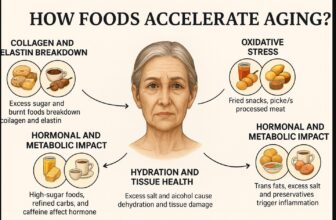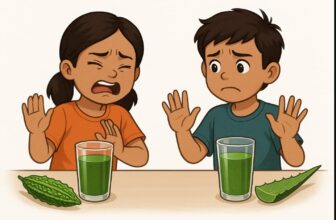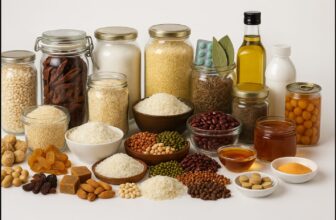Food adulteration is a growing concern in India, where everyday essentials such as milk, spices, and even fruits are often laced with harmful chemicals, synthetic additives, or low-quality substitutes. These hidden contaminants are added to enhance color, increase shelf life, or cut production costs—often at the cost of consumer health.
The problem is widespread, affecting both urban supermarkets and local markets. Many consumers unknowingly purchase milk mixed with detergents, pulses coated with artificial colors, and fruits ripened with hazardous chemicals. Long-term exposure to these adulterants can cause digestive disorders, kidney and liver damage, weakened immunity, and even life-threatening diseases like cancer.
To protect yourself and your family, it is essential to be aware of which food items are commonly adulterated and how to detect them. This list highlights 13 food products that are frequently contaminated and provides simple, effective tests you can do at home to identify them.
1. Milk – Diluted with Water, Starch, and Detergents
Milk is one of the most adulterated food items in India. It is often diluted with water, which reduces its nutritional value. Worse, starch, synthetic milk, or detergents are sometimes added to maintain thickness and consistency, posing a severe health risk.
Health Risks:
- Consumption of adulterated milk can cause diarrhea, vomiting, food poisoning, kidney issues, and weakened bones.
How to Detect Adulteration:
- For water: Place a drop of milk on a polished surface. If it spreads quickly, it has been diluted. Pure milk leaves a thick white trail.
- For starch: Add a few drops of iodine solution to milk. If it turns blue, starch is present.
- For detergents: Shake milk vigorously. If it forms excessive foam, it may contain detergent.
2. Tea and Coffee – Mixed with Used Leaves and Synthetic Colors
To cut costs, used tea leaves are often dried, colored with iron fillings, and resold. Similarly, coffee powder is sometimes mixed with tamarind seed powder or starch, reducing its quality.
Health Risks:
- Consuming adulterated tea or coffee can lead to digestive issues, liver damage, and slow poisoning due to metal contamination.
How to Detect Adulteration:
- For tea leaves: Place dry tea leaves on moist blotting paper. If color spreads, artificial coloring is present.
- For coffee powder: Add a pinch of coffee to water. If it contains starch, adding iodine will turn the solution blue.
3. Honey – Contaminated with Glucose Syrup and Jaggery
Fake honey is often made using glucose, sugar syrup, or jaggery, which lacks the natural enzymes and antioxidants of pure honey.
Health Risks:
- Adulterated honey increases the risk of diabetes, obesity, and metabolic disorders.
How to Detect Adulteration:
- Water test: Drop honey into a glass of water. Pure honey will settle at the bottom, while fake honey dissolves quickly.
- Thumb test: Place a drop on your thumb. If it spreads, it is impure.
4. Fruits and Vegetables – Coated with Wax, Carbide, and Synthetic Dyes
To make fruits and vegetables appear fresher, vendors coat them with wax, carbide, and artificial dyes. Mangoes, bananas, and apples are often ripened using calcium carbide, which releases acetylene gas, a harmful substance.
Health Risks:
- Long-term consumption of chemically treated fruits can lead to stomach disorders, food poisoning, and neurological damage.
How to Detect Adulteration:
- For carbide-ripened fruits: Soak in water for an hour. If the water turns milky, chemicals are present.
- For wax-coated apples: Scrape the surface with a knife. If a white layer peels off, the fruit has been artificially waxed.
5. Ice Cream – Contains Synthetic Milk and Detergents
Low-quality ice creams are sometimes made with synthetic milk, washing powder, and non-edible synthetic compounds to create a creamy texture at a low cost.
Health Risks:
- Consuming contaminated ice cream can lead to stomach disorders, nausea, and food poisoning.
How to Detect Adulteration:
- Let a spoonful of ice cream melt at room temperature and rub it between your fingers. If it feels soapy, it may contain detergents.
6. Soft Drinks – Loaded with Harmful Chemicals and Artificial Sweeteners
Many soft drinks contain excess phosphoric acid, synthetic sugar substitutes, and artificial colors, which can have serious health consequences.
Health Risks:
- Excessive consumption can cause acidity, tooth decay, insulin resistance, and metabolic disorders.
How to Detect Adulteration:
- If the drink has an unusually strong artificial sweetness or excessive fizz, it may contain chemical additives.
7. Salt – Mixed with White Powder and Chalk
To increase weight, common salt is sometimes mixed with chalk powder or white powdered stone, which reduces its purity.
Health Risks:
- Contaminated salt can lead to kidney damage, hypertension, and digestive issues.
How to Detect Adulteration:
- Dissolve a teaspoon of salt in water. If white residue remains, chalk powder is present.
8. Sugar – Contains Washing Soda or Chalk Powder
To increase bulk, sugar is sometimes mixed with washing soda or chalk powder, making it harmful for consumption.
Health Risks:
- Consuming adulterated sugar can cause gastric problems and disrupt calcium balance in the body.
How to Detect Adulteration:
- Dissolve a spoonful of sugar in water. If it turns milky, chalk powder is present.
9. Pulses – Polished with Artificial Colors and Lead-Based Chemicals
Many pulses, like tur dal and moong dal, are artificially polished using toxic chemicals to enhance their color and appearance.
Health Risks:
- Lead contamination can cause organ damage, neurological disorders, and food poisoning.
How to Detect Adulteration:
- Soak pulses in water for 30 minutes. If the water turns yellow, artificial coloring is present.
10. Rice – Mixed with Plastic or Synthetic Grains
Fake rice made from plastic and synthetic resin has been found in some markets, posing a severe health hazard.
Health Risks:
- Plastic rice can cause digestive problems, food poisoning, and intestinal damage.
How to Detect Adulteration:
- Burn a few grains with a lighter. If they emit a plastic-like smell, they are fake.
- Drop rice into water. Plastic rice floats, while real rice sinks.
11. Mustard Seeds – Mixed with Toxic Argemone Seeds
Mustard seeds are sometimes mixed with argemone seeds, which are highly toxic.
Health Risks:
- Argemone seeds can cause food poisoning and liver toxicity.
How to Detect Adulteration:
- Crush mustard seeds. If they release yellow oil, argemone contamination is present.
12. Turmeric and Spices – Contaminated with Lead and Chemical Dyes
Turmeric, chili powder, and coriander powder are sometimes mixed with lead chromate, brick powder, or chemical dyes to enhance color.
Health Risks:
- Consuming contaminated spices can lead to liver damage, kidney disorders, and long-term toxicity.
How to Detect Adulteration:
- Add a teaspoon of turmeric to warm water. If a yellow layer settles at the bottom, it contains lead chromate.
13. Ghee – Mixed with Vanaspati and Starch
To cut costs, ghee is often mixed with vanaspati (hydrogenated vegetable oil) or starch.
Health Risks:
- Fake ghee can increase cholesterol and pose heart disease risks.
How to Detect Adulteration:
- Melt a spoonful of ghee and add iodine. If it turns blue, starch is present.
Conclusion – Adulterated Foods in India That Could Harm You
Food adulteration is a silent but serious health hazard affecting millions of Indian consumers. From detergent-laced milk to carbide-ripened fruits, many of the items found in local markets contain harmful substances that can lead to severe health complications if consumed over time.
This guide helps you recognize 13 commonly adulterated foods and provides easy home tests to check for contaminants. By staying informed and taking simple precautions, you can safeguard your health and make better purchasing decisions.
Be a smart consumer, know what you eat, test your food, and choose safety over convenience.





